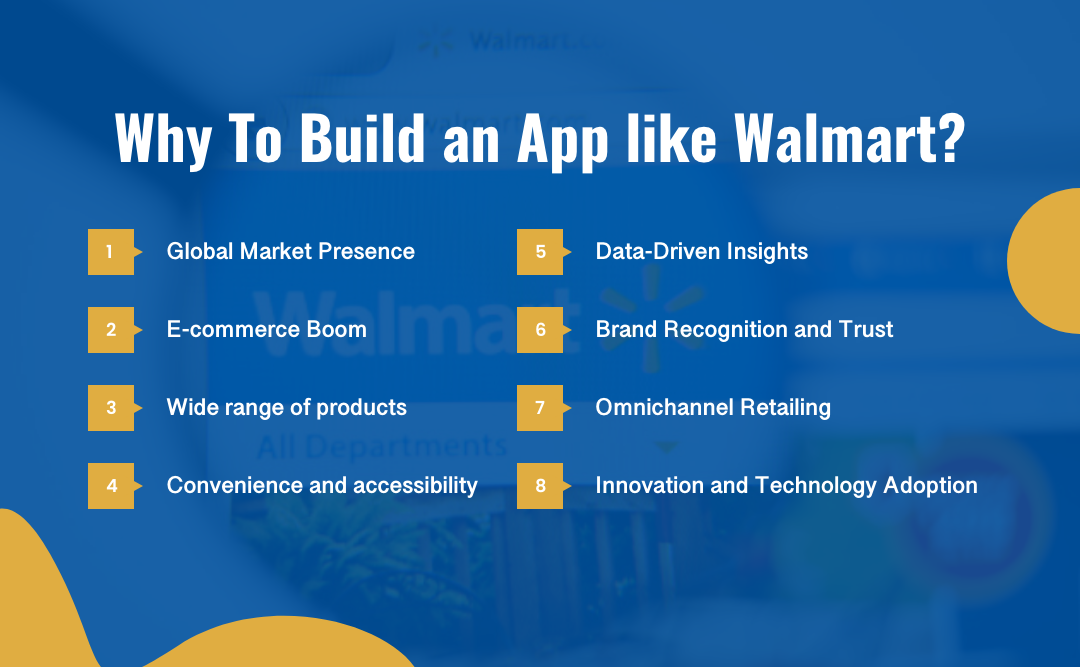Walmart is a giant in the retail industry, and its innovative business strategy has made it a leader. Walmart was founded by Sam Walton in 1962. The retail giant has integrated a cost-leadership approach and leveraged economies of scale for consumers to get unbeatable deals.
Walmart has revolutionized retail with its extensive supply chain, advanced technologies, and commitment to efficiency.
Walmart business model, which combines physical stores and a robust web presence, meets the diverse needs of consumers.
This blog explores the complexities of Walmart business model. It examines its key strategies, technology advancements, and impact on the retail industry. We invite you to join us as we explore the success story of the retail giant and uncover the secrets that have led it to its enduring dominance.
Table of Contents
Walmart’s Business Model Canvas
Walmart, one of the world’s largest and most successful retailers, has a model that incorporates several key elements. Business model canvas walmart is a strategic tool for managing business models. It provides a visual framework to develop, describe, and align them.
Walmart business model can be analyzed using BMC components: Key Partners and Activities, Key Resources (Key Resources), Value Propositions for Customers, Customer Segments, Channels Cost Structures, and Revenue Streams.

1. Customer Segments:
Walmart’s main customer segments are value-conscious shoppers who want low-cost everyday products. Walmart caters to many different demographics, including low- and middle-income families. Walmart also serves small businesses, and its e-commerce clientele is growing.
2. Value Propositions
Walmart’s value proposition is based on offering various products at low prices. The company focuses on efficiency and passes cost savings onto customers.
Walmart business model’s core value proposition is convenience, “Everyday Low Price”, and the one-stop shopping experience.
3. Channels:
Walmart business model uses a multichannel approach with an extensive network of physical stores and an increasing online presence. Brick-and-mortar shops are the main channel for Walmart, offering a convenient way to shop. Walmart has also invested heavily in online commerce, expanding the platform to reach global customers.
4. Customer Relationships
Walmart business model is focused on creating long-term relationships. Walmart’s customer service is a priority, and its associates are crucial in creating an enjoyable in-store shopping experience. The online platform increases customer engagement by providing personalized recommendations and ensuring efficient order fulfillment.
5. Revenue Streams
Walmart business model makes money by selling various goods, such as groceries, electronics and clothing. The company also generates revenue through its e-commerce platform. Although the company has thin profit margins, it benefits from its high sales volume.
6. Key Resources
Walmart business model’s primary resources are its vast network of physical retail stores, a robust and efficient supply chain, sophisticated inventory management systems, and a solid online presence. Technology is used by the company for data analytics, optimizing operations, and improving customer experience.
7. Key Activities
Walmart business model activities include procurement, inventory management, supply chain control, and efficient operations in stores. The company constantly works to optimize its supply chains, negotiating with vendors for the best price. Walmart invests in innovation and technology to keep up with the retail industry.
8. Key Partners
Walmart business model works with many different partners. Relationships with suppliers are essential to ensure a constant supply of low-cost products. The company partners with technology companies to improve its digital capabilities.
9. Cost Structure
Walmart business model cost leadership strategy aims to keep costs low to provide competitive prices. Major cost components are procurement, logistics, and store operations.
Technology investments also play a significant role. A company’s streamlined supply chain and economies of scale allow it to operate with thin profit margins.
Walmart SWOT Analysis
Now that you know the Walmart business model, it is crucial to know that the SWOT Analysis (Strengths, Weaknesses, Opportunities, and Threats) provides valuable insight into the internal and external factors affecting its business.
1. Strengths:
- Market Leadership
The business model of walmart provides incredible market leadership is one of its key strengths. Walmart is a household brand with a global presence and an extensive range of services and products.
- Economies of scale
Walmart’s size enables it to realize economies of scale and reduce costs by bulk purchasing. The company can offer customers competitive prices, which is a significant factor in its success.
- Supply Chain Management
Walmart’s supply chain management system is highly regarded. The company has heavily invested in technology to optimize the supply chain. It reduces lead times and ensures that products are delivered efficiently to stores.
- Diverse Product Portfolio
Walmart’s product range spans many categories, including groceries, electronics, and apparel. This diversification minimizes the impact of economic downturns within any particular sector and provides stability to the business.
- Global Presence
Walmart app development has a global footprint by operating in several countries. Walmart can diversify its revenue streams and adapt to changing market conditions.
2. Weaknesses:
- Work Relations
Walmart has been criticized for its low wage and limited-benefit policies. The company’s reputation has been negatively affected by negative publicity, strikes, and legal challenges.
- E-commerce Challenges
Walmart faces fierce competition from online retailers such as Amazon despite its significant investment in e-commerce. To remain competitive, the company must adapt to an ever-changing digital landscape.
- Overdependence on the U.S. market
Walmart generates significant revenue in the U.S. Walmart’s overdependence on one market leaves it vulnerable to changes in U.S. economic conditions, regulatory issues, or other domestic challenges.
- Negative Public Perception
Walmart has received criticism for its impact on small businesses and environmental and social issues. A negative public perception may influence consumer behavior or affect a company’s brand image.
- Bureaucratic Structure
Walmart’s size, organizational structure, and bureaucracy can cause challenges. The company may need a faster decision-making process, which hinders its ability to react quickly to changes in the market.
3. Opportunities:
- E-commerce Growth
Walmart has an excellent opportunity to capitalize on the continued growth of online retail. Walmart can enhance its digital capabilities and expand its online presence to capture a more significant share of the online retail market. Hire dedicated developers if you want to build an app like Walmart.
- Expanding Internationally
Walmart can expand its presence further in emerging markets. By investing in untapped markets, Walmart can diversify its revenue streams and lessen its dependence on a single market.
- Technological Advancements
Walmart can improve its customer service, increase operational efficiency, and remain at the forefront of technology by embracing emerging technologies such as artificial intelligence, data analysis, and automation.
- Health and Wellness Market
Walmart’s offerings can be expanded in this segment by focusing on health and well-being. It includes organic products, fitness gear, and healthcare services.
- Strategic Partnerships
Walmart can benefit from new business opportunities by collaborating with other companies in the tech sector. Partnerships are a great way to reach new customers and develop innovative solutions.
4. Threats:
- Competition
Walmart is under threat from fierce competition by traditional retailers and online giants. Walmart must constantly innovate to remain competitive. The retail environment is changing.
- Regulation Challenges
Walmart has operations in several countries, each with its own regulations. The company’s profitability and processes can be affected by changes in labor laws, trade policies, or other restrictions.
- Economic Downturn
Walmart’s business depends on economic conditions. In an economic recession, shoppers may reduce spending for non-essentials, affecting the company’s profitability and sales.
- Supply Chain disruptions
Natural disasters, geopolitical tensions, or global health crises can affect supply chains and increase costs.
- Cybersecurity threats
As a large retailer that handles vast amounts of customer data, Walmart is vulnerable to cyber threats. Data breaches are not only damaging to the reputation of a company but can also have legal and financial implications.
Walmart’s Competitors
Walmart is a retail giant that faces competition from various players, from brick-and-mortar retailers to e-commerce giants. Understanding the landscape of Walmart’s competitors is crucial to assessing the challenges and opportunities within the retail sector.

1. Amazon
Amazon’s e-commerce platform has revolutionized retail with its vast product selection, efficient logistics, and emphasis on innovation.
Amazon’s extensive product range, efficient logistics, and focus on innovation have made it a leader in the online retail industry.
Prime membership, which offers benefits such as free shipping and exclusive material, has helped to increase customer loyalty. Amazon’s acquisition of Whole Foods expanded its grocery business, directly competing against Walmart’s grocery division.
2. Target
Target is one of Walmart’s main competitors, especially in the United States. Target, a retailer known for stylish and affordable products, has carved a niche in the market.
Target’s focus is on exclusive brands and partnerships. It also offers a compelling experience in the store. Target is often positioned as a more design-focused and curated option, while Walmart caters to a broader customer base.
3. Costco
Costco is a membership-based company competing against Walmart in the retail and wholesale sectors. Costco’s membership program and emphasis on bulk purchases help to retain customers.
On the other hand, Costco targets a specific demographic looking for bulk purchasing and value. It appeals to both businesses and consumers. Get in touch with the best ecommerce app development company to build an app like Costco.
4. Kroger
The grocery retail industry is dominated by Kroger, which poses a severe threat to Walmart. Kroger, which focuses on fresh and local products, competes directly against Walmart’s grocery offering. Kroger also invests in technology. It offers online grocery services and explores partnerships to enhance digital capabilities.
5. Alibaba
Alibaba is a significant competitor in the global context. It includes Walmart’s international business. Alibaba has grown its worldwide reach and dominates the Chinese e-commerce industry.
Its e-commerce ecosystem, cloud services, and digital payment options provide a complete online experience. Walmart has responded by increasing its presence in the Chinese market.
6. Dollar General
Dollar General is a competitor to Walmart in the retail discount sector. It offers a variety of low-cost items. Dollar General targets budget-conscious customers, while Walmart caters to many consumers.
Dollar General’s smaller format and emphasis on convenience make it a formidable rival, especially in rural areas and underserved regions where Walmart may have larger supercenters.
7. Aldi Lidl
Aldi, a German discount supermarket chain, and Lidl have expanded into the United States. They compete with Walmart for the grocery retail market. Aldi and Lidl are known for their focus on value and cost-efficiency. It appeals to consumers looking for affordable options.
8. Home Depot and Lowe’s
Home Depot, Lowe’s, and other home improvement retailers threaten Walmart. These companies offer products to customers interested in home improvement, gardening, and other related projects. Walmart’s Home and Garden section competes against these specialty retailers to capture a portion of discretionary consumer spending.
Why Build an App like Walmart?
For entrepreneurs or businesses looking to enter retailing or improve their current operations, it is crucial to build an app like Walmart that offers a variety of strategic advantages. Consider these eight compelling reasons for developing an app similar to Walmart.

1. Global Market Presence
Walmart is a global leader, and creating an app similar to Walmart allows you to tap into this vast market. You can expand your business by offering various products via a mobile app.
2. E-commerce Boom:
Walmart’s app allows you to take advantage of this trend. A robust e-commerce platform is essential to attract and retain customers, as consumers prefer online shopping for convenience. If you want to build an ecommerce app like Walmart it is crucial to hire dedicated developers.
3. Wide range of Products:
Walmart’s huge product selection, which includes everything from groceries to electronic devices, is a significant factor in its success. A diverse product catalog allows you to meet the needs of a wide range of customers and become a one-stop shop for all their requirements. It can increase customer loyalty and average transaction value.
4. Convenience and Accessibility:
Mobile apps provide unparalleled convenience by allowing customers to shop at home or on the move. You can improve customer convenience and accessibility by creating a seamless shopping experience app. It aligns with Walmart’s commitment to making shopping simple for their customers.
5. Data-Driven Insights:
Walmart uses data analytics to optimize inventory and improve the overall shopping experience. You can gather valuable information about customer preferences, purchasing patterns, and more by developing an app.
This data will help you make better business decisions and can be used to tailor your products to customer needs. Contact a mobile app development company if you’re curious to build an app like Walmart.
6. Brand Recognition and Trust:
Walmart is synonymous with trust and reliability. When building an app, a similar commitment to affordability, quality, and customer satisfaction can help establish your company’s brand. The confidence of a reputable brand can help you increase customer retention and acquisition.
7. Omnichannel Retailing:
Walmart is a leader in omnichannel retailing. It seamlessly integrates its physical stores and its online platform. Customers can have more flexibility with an app that supports omnichannel services, including in-store pickups, online ordering, and delivery options. This integrated approach improves the customer experience, which encourages repeat purchases.
8. Innovation and Technology Adoption:
Walmart invests continuously in technology to remain ahead of the curve. You can incorporate innovative features into your app, including augmented reality virtual try-ons and personalized recommendations based on user preferences. Tech-savvy users will be attracted to your app if you keep up with the latest technological advances.
Conclusion
Understanding the Walmart business model is a key to success in retail. Modeled after Walmart’s business model, the Shopping & Savings App promises a one-stop-shop experience at unbeatable rates.
This app embraces technology, optimizes the supply chain, prioritizes customer satisfaction, and aims to redefine how consumers shop.
It focuses on efficiency and value to ensure users a convenient, cost-effective, and convenient shopping experience. Hire mobile app developers if you want to build an app like Walmart with incredible opportunities.

























